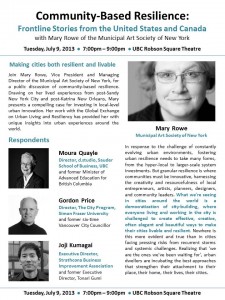Last week was “resilience” week in my life. Tuesday night we were at Robson Square for “Community-based Resilience: Front-Line Storiesfrom US & Canada. We were fortunate to have Mary Rowe visiting from the Municipal Arts Society of New York (MASNY). I called Mary the “doyenne of resilience” — she has taken MASNY from being simply concerned with city livability (still important) to being leaders in thinking about and doing something about urban resilience. Around 30 of us (mainly local) then spent Wednesday discussing and debating the interactions of global urban livability and resilience.
On Tuesday night Mary shared her on-the-ground experiences in the aftermath of Katrina and superstorm Sandy illustrating the power of the local through stories about people making a difference in their communities. On the responding panel along with me were Gord Price (always up for a debate — suggesting that big systems aren’t going away…) and Joji Kumagai, ED of the Strathcona Business Improvement Association who also presented on-the-ground experience in his community.
Building on Mary’s presentation, I proposed 3 ideas or “calls to action” that are important for community-based resilience in Metro Vancouver and virtually any place:
1. Investing in youth & distruptive learning environments for resilience preparation
2. Demanding Q.Helix Co-creation: civil society, business, government, academia collaborating
3. Promoting the start-up and up-start city
INVESTING IN YOUTH: THE NEED FOR DISTRUPTIVE LEARNING ENVIRONMENTS FOR RESILIENCE PREPARATION
Main theme here is around what is plaguing me a lot lately — too many meetings doing planning for the future without a range of generations in the room — namely teen-agers, 20 and 30-somethings. We really need to invest way more in thinking about our youth — especially around how we educate them to be agile and nimble thinkers.
Questions:
• How do we get people to be more comfortable with questions rather than answers?
• How do we overcome fear – often of ambiguity?
• How to we encourage more process thinking and more active community engagement into our learning enviornments? They are too passive and not focussed enough on building problem solving skills. Learning how to ask good questions might be the most important skill we can nurture in our youth.
• How do we provide more opportunities for students to “learn by doing” – if we want to build community-based resilience – it is about thinking and then doing. Don’t want to be stuck in analysis or planning for ever. Of course, one answer is the STUDIO!
